Jump to Section
Everyone loves risotto. After all, it’s rich, creamy and just so comforting! But, I know for a fact that most people are intimidated by it. Yes, it does take some babysitting and constant stirring, but it really doesn’t take as long as you think to make a
I find that the longest part is actually preparing the flavourings. For example, chopping all the herbs for my foolproof fresh herb risotto can take 15 minutes minimum, whereas cooking the actual risotto only takes 20-25 minutes! Plus, if you know the secret formula for perfect risotto, it’s foolproof! I promise you that you too can learn how to cook a perfect and creamy risotto to dazzle your friends and family!
Plus, it’s worth the effort – risotto is the ultimate comfort food. It’s so rich and creamy that sure, it might not be diet food, but who cares? A nice big bowl of risotto is just too good to pass up.
The Ingredients
For a plain risotto, you need olive oil, butter, onion, garlic, rice, stock and parmesan. Of course, after that, you need to season it with salt and pepper. With all of these ingredients, there are tips and tricks to get them right.
The Olive Oil & Butter
Use good quality ingredients and it will taste better, I promise! You want to use nice quality, real butter for a proper creamy texture and richness. As for the olive oil, this isn’t quite so important, but good quality olive oil is always worth using when cooking.
You add butter both at the beginning and the end, so this is extra important. Good quality, room-temperature butter helps to ensure a creamy texture as you finish the risotto. Be generous with the butter too! After all, fat is flavour!
The Onion & Garlic
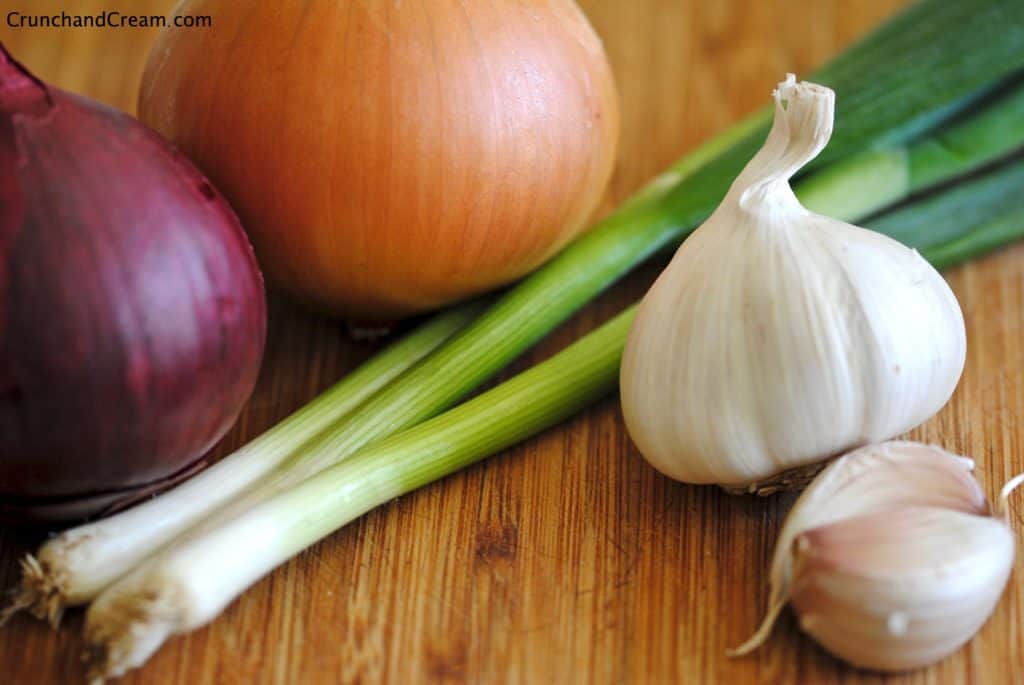
I like to use red or yellow (white) onions in my risotto depending on the flavour profile. Both work very well in my fresh herb risotto, however, only yellow (white) onions work well in my orzo pasta version of risotto, for example. It’s important to consider the overall flavour profile of your risotto when choosing a type of onion. Shallots also work very well as they’re lovely and mild.
Personally, I prefer medium-diced onion as it still has some texture. After all, when cooking risotto, your onion has almost the entire cooking time to soften, so the size of your dice plays a big part in the texture of the dish. If you’d like to keep your onion chunky in larger pieces then go for it! It adds great texture that way!
I like to mince my garlic, but you can also crush it. Just make sure that you use a good amount of nice fresh garlic for great flavour. You could absolutely use roasted garlic instead for a slightly different flavour.
If you’re in a hurry or struggle to mince garlic (it’s fairly hard on your hands), then use 1 teaspoon of jarred minced garlic per clove in the recipe. I often do. this on days when my hands are particularly painful or I’m starving and don’t really want to chop up the garlic as well as all my herbs and onion.
The Rice
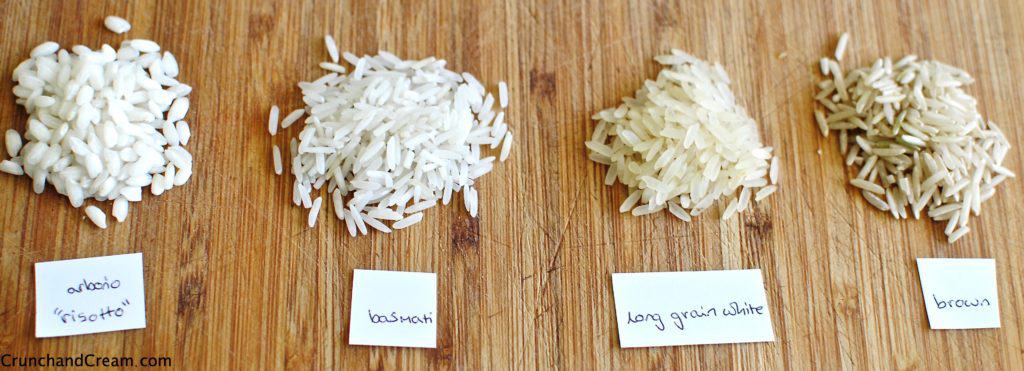
Traditionally, risotto is made with arborio or carnaroli rice. I always use arborio rice as that’s what’s available to me locally. However, any rice labelled as ‘risotto rice’ should work.
Other types of rice do not work as substitutes – you need a very starchy short-grain rice to give your risotto it’s signature creamy texture. Otherwise, the rice won’t release as much starch, and so won’t be creamy. As you can see in the image above, risotto rice is much rounder, and the individual grains are plumper. They are also less translucent because of all the starch inside. It’s this starch that gets released during cooking and creates the white ‘sauce-like’ substance. This is what you need for a perfect risotto!
This is a key problem many people have when learning how to make risotto: other rices are not the same! Just like wild rice, brown rice and basmati rice are different, so is risotto rice.
You can make dishes with a similar texture to risotto out of other grains such as quinoa, orzo pasta or pearl barley too. However, I will cover those later. For now, it’s best to master risotto the traditional way.
As risotto is made with rice, providing the rice was not cross-contaminated during packaging, it should also be gluten-free. However, some stock cubes and other ingredients contain gluten, so it is important to be vigilant when checking labels if you’re gluten intolerant.
The Stock
In risotto, the stock plays a really big part in the eventual flavour of the dish as it’s what the rice is cooked in. Personally, I use only stock and no wine as I prefer to cook without alcohol. However, traditionally, any type of dry white wine is used. However, if you want to add wine, add it before the first ladle-full of stock and let the rice absorb it. You should only need around 1/2 a glass of wine.
In terms of the type of stock, it’s important to consider the other tastes at play in your risotto. As a base for plain risottos, I’d recommend using chicken or vegetable stock. However, if you’re adding a different type of meat or want a different flavour profile, you can absolutely use beef or any other type of stock instead.
Personally, I stick to veggie stock as my family includes 2 vegetarians, but that’s a personal choice; chicken stock is more commonly used.
It’s best to use a good quality stock. If possible, a homemade, fresh broth is best. However, that takes lots of time that many of us just don’t have, so store-bought broth is absolutely ok too! It’s best to try to stick to the ready-to-use broth often sold in tubs. However, I’ll be honest – I usually just use stock cubes for the convenience. They still add some good taste even if they don’t have the same nutrients or depth of flavour.
You can actually use other liquids instead of broth to cook the rice once you’ve got the hang of how to make a more basic risotto. For example, in my tomato risotto with chargrilled veggies, I use crushed tomatoes to replace some of the stock and flavour the rice itself! This is where you can start being creative with different liquids – why not try a few?
The Parmesan
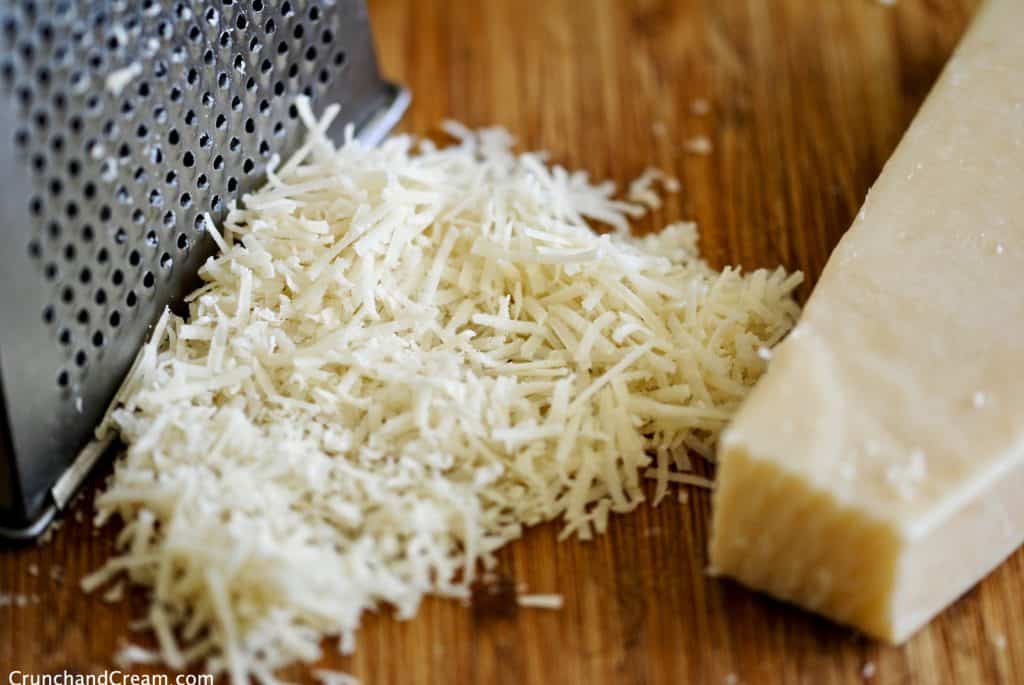
Freshly grated parmesan is king here. Of course, grating parmesan is pretty hard on your hands, so if you struggle, pre-grated is definitely still an option. However, it usually won’t give such a rich and creamy risotto Plus, I find that pre-grated parmesan is often milder, so you may need to use more in order to get the same richness of flavour.
I also often use
The other cheese that I commonly use is grana padano, which is a hard Italian cheese made with unpasteurised cow’s milk. It’s comparable to parmiagano reggiano. This is probably the cheese that I use the most often in risotto, so it’s definitely a good choice. In fact, I might even prefer it to parmesan!
The Seasonings – Salt & Pepper
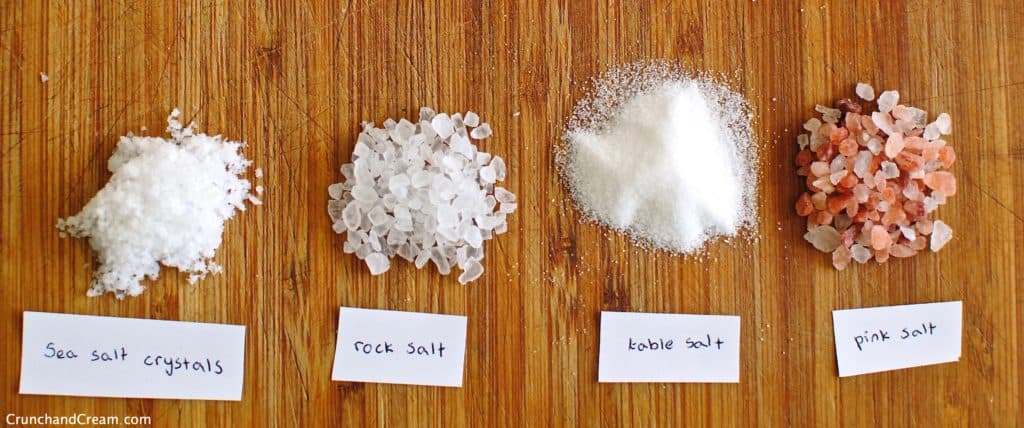
The amount of salt you need to add will depend partially on your stock, parmesan and personal tastes. However, you can be generous – most home cooks chronically under-season their food.
Also, please never use table salt to season food – always choose a sea salt or other unprocessed salt. Table salt is heavily processed and can make dishes taste metallic rather than enhancing the flavours as a good salt should.
Personally, I like to use Cornish sea salt flakes to season my risotto as the different sized flakes stir and melt into the creamy texture very well, and dissolve perfectly on your tongue.
Americans commonly use kosher salt, but really, any type of flaky salt works well. Larger salt crystals (such as in rock salt) are too big and won’t dissolve, so it’s best to stick to flakes if you can.
Other types of salt such as Himalayan pink salt work well too. However, they can be expensive to use for anything other than a garnish, while sea salt is much cheaper.
All salts vary in saltiness, hence why I don’t give a strict amount of salt to add. Different sources and sizes of flakes/crystals affects how they dissolve on the tongue, which is what makes them taste salty. Finer grained salts taste more initially salty, while larger crystals dissolve slower and so the taste will linger for longer.
Part of understanding how to season food is trial and error, so don’t be afraid to try adding a little extra at a time until it’s just right!
If you’re using pepper (which I recommend as it tastes great with the parmesan and other ingredients), stick to freshly ground black pepper unless you know what you’re doing with other coloured peppercorns. They have vastly different flavours and are so strong that they can really make or break a dish.
Key Steps To Make Risotto
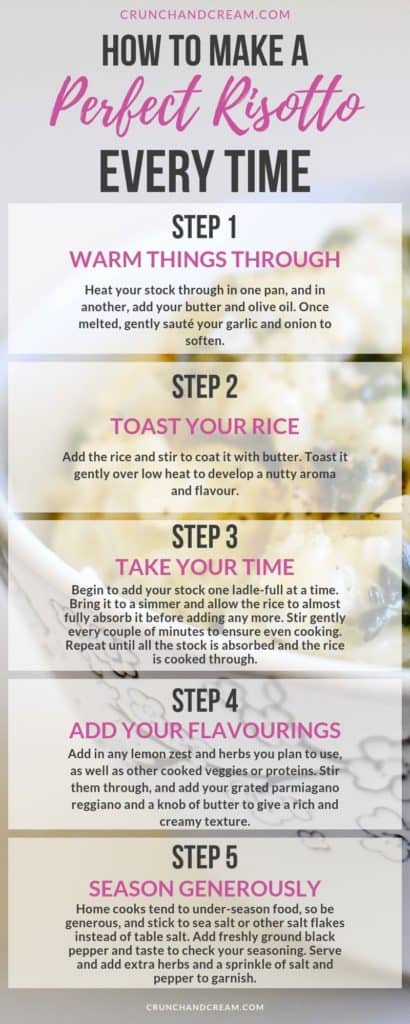
- warm your stock in a pan. You don’t need it simmering, but it should be nice and warm ready to be absorbed by the rice
- in a separate pan, melt the butter with some olive oil. This pan should be on medium-low heat.
- Add your onion and garlic and sauté for 3-5 minutes to soften slightly.
- Add your dry, uncooked rice and stir to coat it thoroughly with butter and toast it slightly for a minute or two.
- If you’re using wine, add it now. If not, add your first ladle-full of stock.
- Bring to a simmer and stir, letting the rice absorb the stock. Once it’s almost fully absorbed, add another ladle-full of stock and repeat until the stock is used and the rice is cooked through.
- Remove from heat completely. Add your butter, parmesan and other flavourings (e.g. fresh herbs). and stir until it reaches a creamy consistency.
- Serve and enjoy!
The Ratios of Ingredients
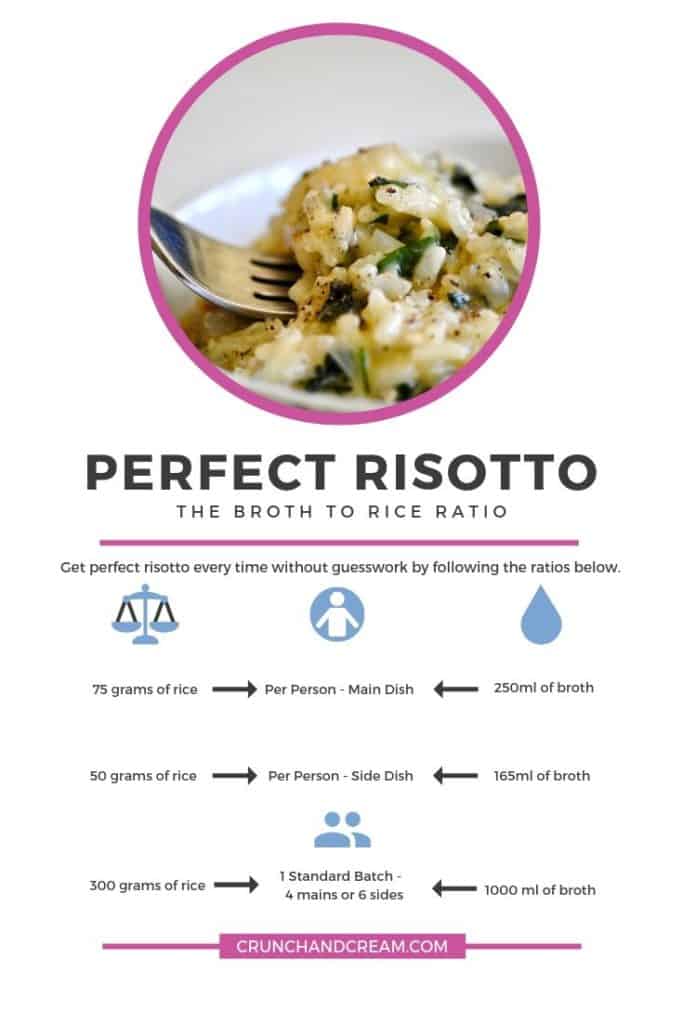
A timeless question about risottos is how much stock to add. Get it wrong and it’ll be either undercooked or soupy. However, the perfect ratio that works every time for me is:
1 litre of stock for every 300 grams of rice
I always stick to this ratio. It serves 6 as a side dish or 4 as a main dish, per person:
per person (main dish) – 75 grams of rice, 250 ml of stock
per person (side dish) – 50 grams of rice, 165 ml of stock
For 6 people, I use 2 cloves of garlic and 1/2 large white onion or 1 small red onion. Obviously, this doesn’t translate so well
The amount of stock you add will partially depend on your preferences; I like a tighter risotto, so those are the ratios I use. However, you may want to use an extra 30ml of stock per portion if you prefer a looser, soupier risotto.
Choosing a Flavour Profile
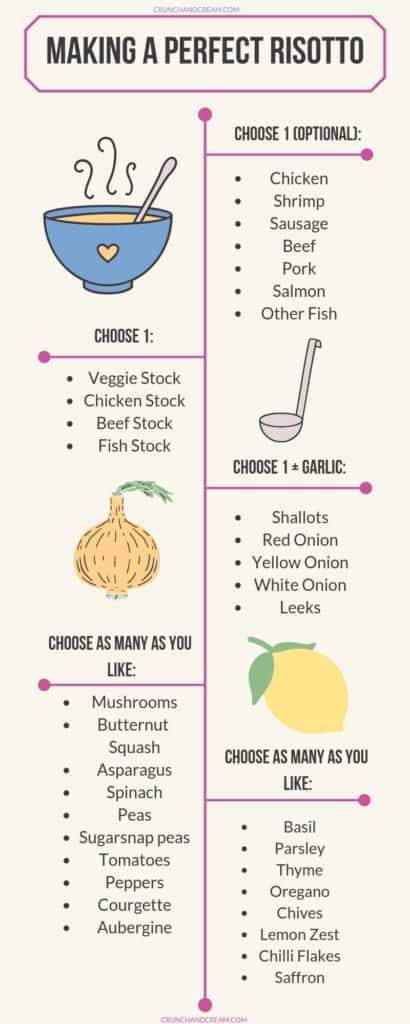
Stick with combinations you know and love!
For example:
- fresh herbs and lemon with veggie stock and white onion
- swap passata (sieved tomatoes) for some of the stock, use red onion and add in basil and chargrilled veggies & crispy bacon or pancetta
- lemon zest and green Spring veggies such as asparagus, baby spinach, peas, basil and parsley with finely diced white onion
- roasted garlic, sage and mushrooms are always a good combination
- lemon zest, juice and shrimp cooked in parsley butter
Ingredients to add Flavour
With the ingredients you choose, there are often different ways to use them. For example, if you choose sausage as a protein, you could make either this sausage and white wine risotto or this sausage, tomato and roasted garlic risotto. While these are very different flavour profiles, both use sausage and white wine with chicken stock as the base!
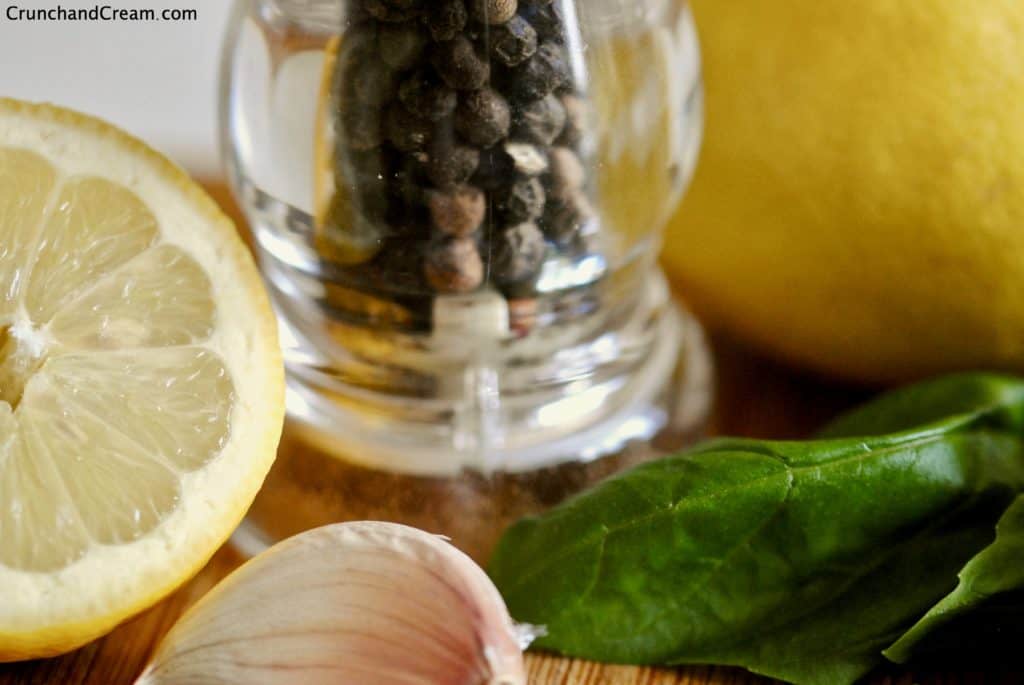
If you choose to use fresh ingredients like herbs or lemon juice, it’s best to always use fresh. Stay away from dried herbs and bottled lemon juice if you can. They just don’t have the same flavour. Plus, dried herbs need to be added earlier in the cooking process in order for the flavour to develop.
However, dried and dehydrated mushrooms can work well! This is because you’d rehydrate them and then use that liquid instead of broth to add flavour! With mushrooms, you also add them earlier in the cooking process either just before or at the same time as you add the wine.
However, as I can’t eat mushrooms and none of my family like them, it’s best to use a reference recipe. This allows you to work out when is
Despite this, many recipes using mushrooms work well with any fresh mushrooms of your choice (such as this one). This means that you don’t have to worry about soaking them and then perhaps using that liquid instead of some of the broth! This makes using mushrooms in risotto much easier. I definitely recommend doing it this way if you’re looking for an easy way to make a great risotto.
You can also use saffron in a risotto like this. To do this, you add the saffron with the first of the stock. This helps to give your risotto a vibrant yellow colour and the delicate flavour of saffron. It’s a lovely and fairly traditional way of flavouring risotto, and is usually kept plain otherwise in order to show off the use of the saffron properly – other flavours might overwhelm it.
Use of Unusual Flavours
However, some rather unusual and out-there flavours can work very well in risotto. For example, try this red curry & grilled shrimp risotto. It uses Thai red curry paste and coconut milk to add great flavour! If you’re looking for another delicious shrimp risotto then try this asiago risotto with garlic butter shrimp – see, you don’t even have to stick with parmesan in risotto!
If you have the confidence in your flavours and aren’t too worried about it potentially going wrong then it can be great fun to experiment with new flavour profiles! Not every one can be a win, but you could also find your new favourite risotto flavour, so give it a shot!
Mistakes to Avoid – What Not to do when Making Risotto
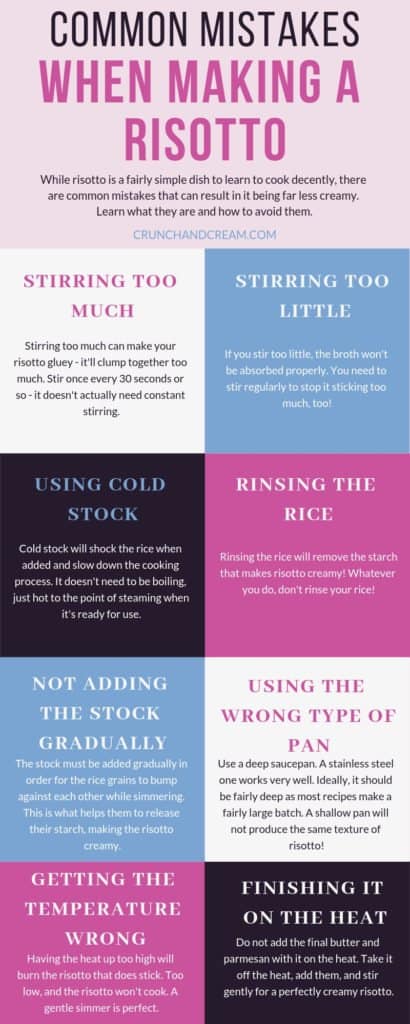
While risotto is easy once you’ve got the hang of it, there are several mistakes that can really mess up the creamy texture that you’re aiming for.
Mistake 1 – Rinsing the Rice
Do not rinse your rice! You want all that white starch as that’s what forms the creamy almost sauce-like substance around the rice. If you rinse it, your risotto will not be smooth and creamy, which would completely defy the point of making risotto.
Mistake 2 – Using Cold Stock
Never add cold stock to warm rice! It will cool the risotto down, meaning that it takes longer to cook, which definitely could make your rich and creamy risotto a complete failure.
Mistake 3 – Adding too much Stock
If you add too much stock all at once, you’re just boiling the rice as normal. This won’t let the starch develop in the same way as when it gently simmers with a little stock at a time. This is because that starchy ‘sauce-like’ stuff has to form gradually as the grains of rice bump up against each other. Add it 1 – 1 1/2 ladle-fulls at a time. No more than that, or it won’t be as creamy. After all, a creamy risotto is a good risotto.
Mistake 4 – Using the Wrong Type of Pan
To cook your risotto, you want a large saucepan, ideally with a heavy bottom and definitely not non-stick. I use a basic stainless steel saucepan and it does the job perfectly. Sure, the rice might stick a little this way. But, it also creates a perfect creamy texture without adding too much stock and overcooking the rice to create mush. Risotto should never be mushy!
You don’t have to worry about these slightly stuck grains of rice burning either, so long as you don’t turn the heat up too high, which brings us to the next mistake you might make.
Mistake 5 – Turning the Heat up too High or Down too Low
Low and slow. The rice should be just about simmering with the stock in. You don’t want a rolling boil, just gentle bubbling. Otherwise, more stock will evaporate and less will be absorbed. Plus, it takes time for the starch to develop and for the rice to absorb the stock. After all, you can’t rush perfection!
However, if you have the heat turned down too low, the broth won’t simmer and it’ll never be cooked. You can wait forever for something to cook if you forget to turn the heat on! In total, it should take around 15-20 minutes for the rice to cook perfectly from the point of adding the first stock.
Mistake 6 – Stirring too Much or too Little
If you stir your risotto too much, especially towards the end, it’ll incorporate air into it. This gives it a gluey texture, which isn’t the smooth creaminess that we’re all craving. You might want air in meringues, but certainly not in a bowl of creamy risotto!
However, if you stir too little, it might not cook evenly. Plus, those grains of rice that do stick are much more likely to burn. Personally, I just stay in the kitchen chopping my herbs or tidying up and stirring it once, gently every 30 seconds or so to ensure even cooking. This is about the right amount to stir.
So essentially, stay in the general area, but you don’t need to watch it like a hawk – it won’t boil over!
Mistake 7 – Adding Butter & Parmesan too Soon (or adding too little)
When the rice is just cooked through perfectly, you should remove the pan from the heat and add your butter and parmesan. They need to melt in with the rice to help that starchy ‘sauce’ become creamier. However, this won’t happen if you add too little. Risotto isn’t exactly diet food, so don’t skimp on them. Always remember that fat is flavour!
If you add them too soon (or while the risotto is still over the heat), the fat will begin to split, creating an odd oily texture that really isn’t very nice. They should be added right at the end after the rice is cooked as butter and parmesan don’t need cooking. For a creamy risotto, they should both just have melted in to the ‘sauce’ to give it that richness. Gently stir them through, and then it’s ready to serve.
Other Ways to Make Risotto
While this post has focused on how to make risotto the more traditional way, it is entirely possible to make a delicious, creamy risotto using other methods.
While I don’t have as much experience with these, they are fairly popular and can be more time and energy-effective depending on how many people you’re cooking for. I like the traditional method if I’m cooking for 4-6 people, but making risotto in other ways is much better if I only need to feed myself.
Baked Risotto
Recently, I’ve also been seeing a lot of baked risottos. These are risottos where you add your stock and rice etc to one pan, put it in the oven and bake it to perfection! How great is that? No stirring required! It’s a great way to make a creamy risotto even easier!
Personally, I haven’t tried any, but if you’re looking for a good recipe, this one has very good reviews! It uses butternut squash and sage to create some beautiful Autumn flavours, as well as some toasted pine nuts for a delicious finishing touch!
Risotto in the Microwave
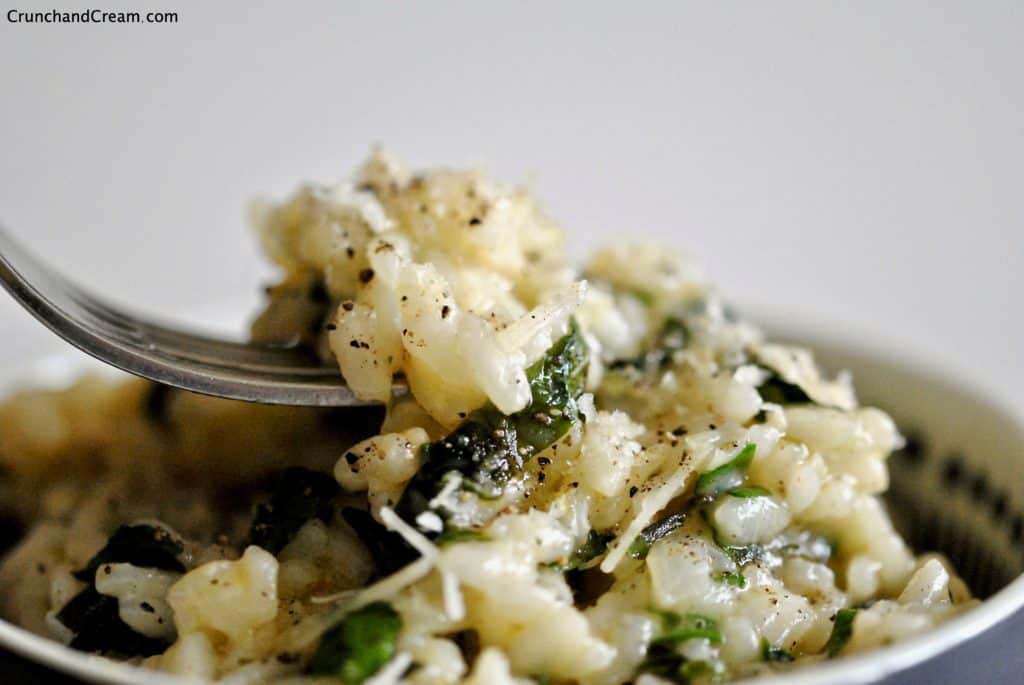
I know I keep mentioning the traditional methods, and this certainly isn’t one of them. However, having tried it, it can work extremely well; I was pleasantly surprised! As it turns out, you can make risotto in the microwave!
I used the base of my fresh herb risotto, converted into a single serving. It actually turned out almost better! The rice was so creamy that just writing this I’m craving more!
Once you’ve got the hang how to make risotto the basic way in your microwave you can try jazzing it up in so many ways! For example, frozen peas and diced bacon! After all, you can cook bacon in the microwave too.
Get my microwave fresh herb risotto recipe here.
Making Risotto-style Dishes from Other Grains
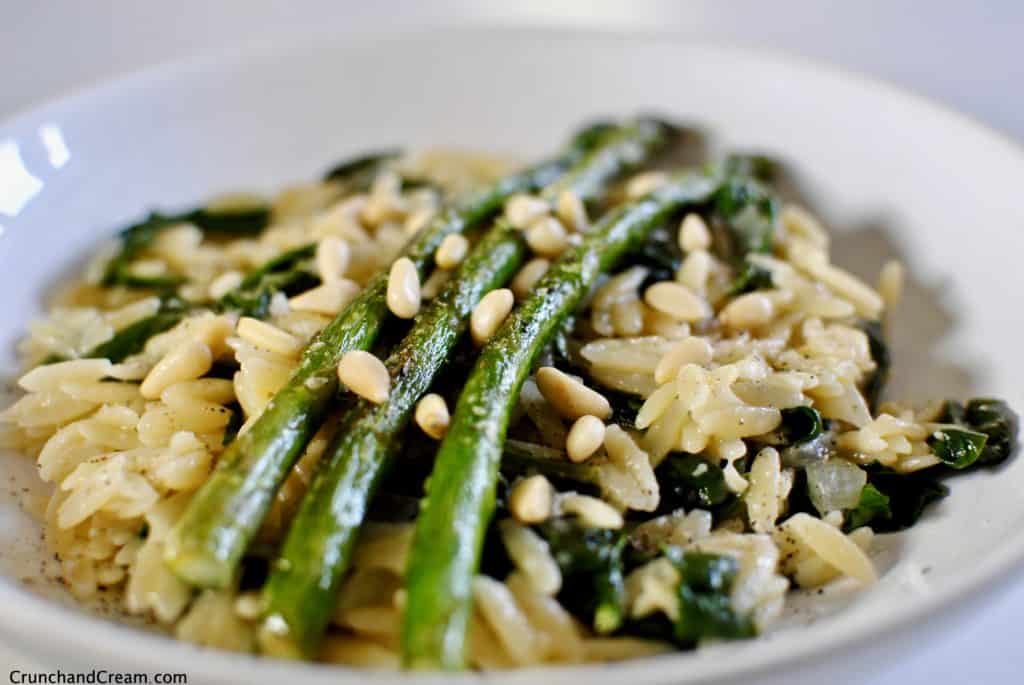
You can absolutely learn how to use other grains to make a rich, creamy risotto-style dish.
For example, you can use:
- Orzo pasta – try this asparagus, lemon and spinach orzo risotto
- Quinoa – try this tomato and basil quinoa risotto
- Pearl Barley – try this mushroom pearl barley risotto
- Bulgur Wheat – try this garlic butter bulgur risotto
- Farro – try this kale and feta farro risotto
- Couscous – try this wild mushroom, chestnut and spinach couscous risotto
- Freekeh – try this artichoke freekeh risotto with bacon
- Regular brown rice – try this brown rice risotto with asparagus, carrots and poached eggs
- Lentils – try this Moroccan lentil risotto with lamb Merguez sausages and cucumber lemon yogurt
- Cauliflower – use cauliflower rice in this keto-friendly risotto with seared scallops
How to Use Up Leftover Risotto
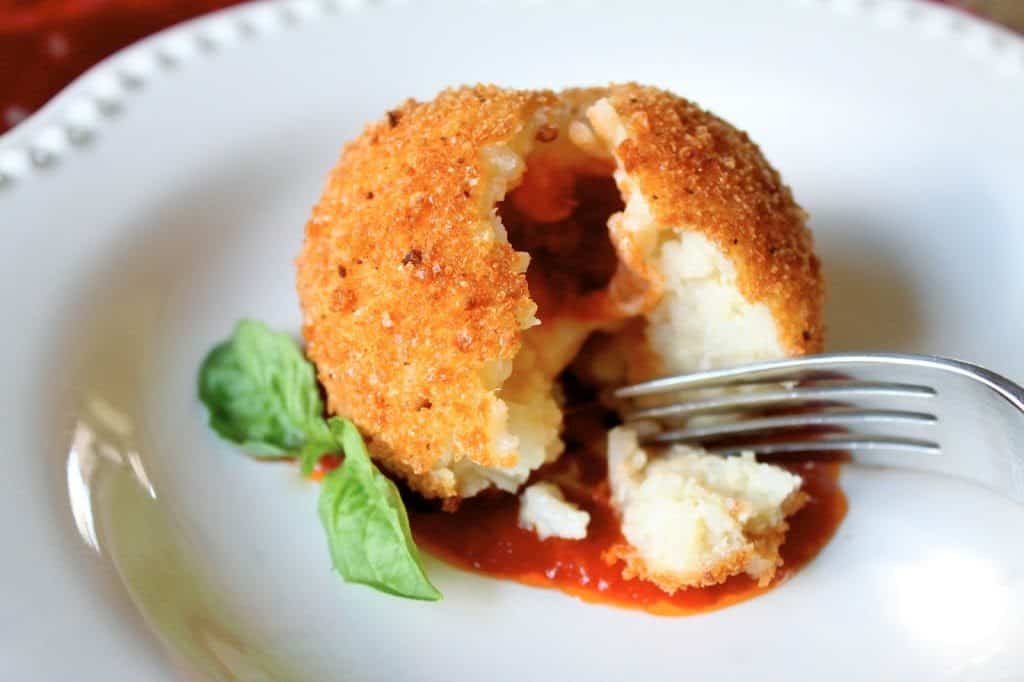
I recommend making risotto in a large batch. That way you can either store and reheat it or make it arancini! If you choose to reheat it, make sure that you are following appropriate food safety guidelines to avoid becoming sick.
Arancini are deep-fried risotto balls coated with breadcrumbs. They make a great snack or side dish. Plus they’re super quick and easy to make once you already have some leftover risotto ready. Try this recipe which uses plain risotto and stuffs it with mozzarella. They’re great dipped in pizza sauce (marinara for Americans) too! This recipe has great reviews and is definitely a good way to enjoy your leftover (usually slightly less creamy) risotto.
To cool risotto safely, leave it at room temperature uncovered, spread in
Or, you can make risotto stuffed peppers or tomatoes – try this recipe for Sicilian risotto stuffed peppers. All you do is spoon your risotto into the veggies, top with cheese and bake! It’s simple, and a delicious way to shake things up. Plus, it’s slightly healthier than the arancini! The recipe also uses a great flavour profile that matches the peppers perfectly – ground beef, peas and tomatoes! It’s a very original recipe and looks absolutely delicious.
How to Reheat Risotto Without Losing the Creamy Texture
Note – caution must be taken in order for you to not become sick. I do not take any responsibility for your becoming sick if you try it. However, it’s the method that I use to reheat my risotto.
- Add 1 tbsp of water per portion of cold risotto and mix it in
- Microwave for 1 minute, then stir and repeat.
- if your risotto is not piping hot, microwave for a further 30 seconds as needed.
The water is needed to help rehydrate the rice to give you that creamy risotto texture. I also often add more parmesan, salt and pepper when reheating risotto, but this is optional.
I often reheat risotto in this way and then take my leftovers to school for lunch in my food thermos! It’s a great way to enjoy risotto for most of the week, so I really recommend using one if you prefer hot lunches.
Yes, this does, in fact, mean that you can meal prep risotto. It’s so easy to make a big batch at the weekend and reheat it for the next few days that I fully recommend it! After all, who doesn’t want to eat risotto every day?
One Final Tip…
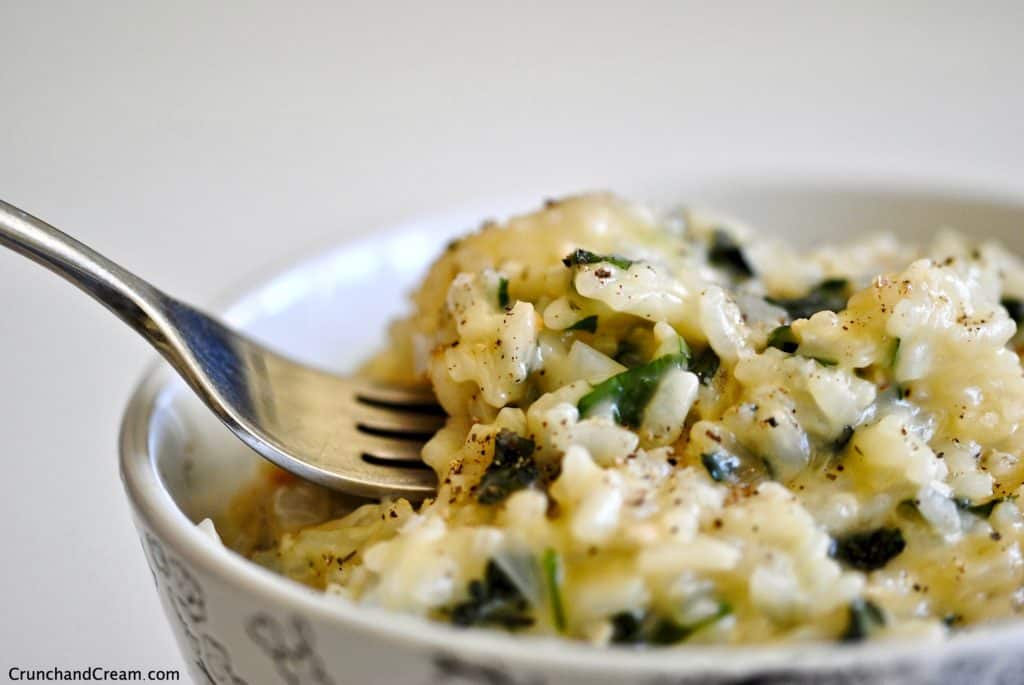
Practice makes perfect! Sure, your first attempt at making risotto might not be the best, but you didn’t learn how to walk the first time you tried either! Learning how to make risotto takes a little practice. Just because you know how to make a perfect, creamy risotto in theory, doesn’t mean that you can be perfect on the first try! My risotto still varies in quality and sometimes is a tad gluey even though for a while I was making one batch per week!
My advice is to cut yourself some slack as you learn, and just enjoy eating the results no matter what! The first risotto that I ever made was my foolproof fresh herb risotto. However, you could also try the single-serving microwave version. Both of these are about as simple and delicious as it gets, so try one of those first if you’re feeling a little lost! My tomato risotto with chargrilled veggies is also pretty simple (and slightly healthier) so that’s a good option too.
If you follow these tips on how to make risotto, let me know on facebook,
Have fun cooking, and eat plenty of risotto!
Post linked to #CookBlogShare
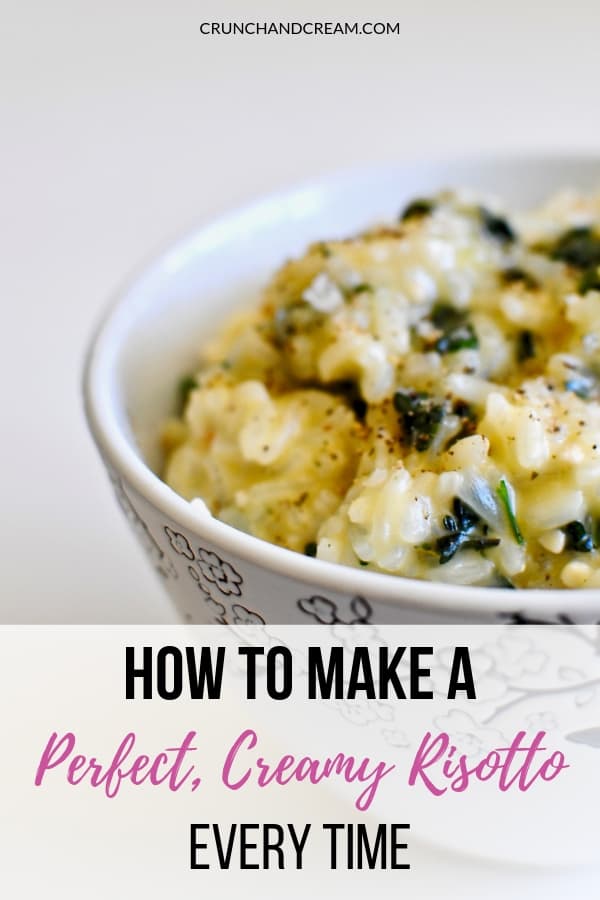

I love making Risotto, I find all the stirring very soothing! I always use Arborio rice too!
I agree about the stirring – it’s such a good way to relax! I don’t get why some people hate it so much at all! What sort of flavours do you usually use in your risottos?
Wow! That’s a fantastic post. I love risotto and I’m always looking for ways to improve mine. Thanks!
I’m so glad that you found it useful! What’s your favourite type of risotto? Most people seem to like mushroom best, but that’s not too popular in our house!
Crammed packed full of useful info and tips! Brilliant ?
Thanks! I’m so glad that you think it’s useful and I hope you give making risotto a shot and it turns out well for you!
I love risotto but I had troubles getting it right. Thanks for all this info on common mistakes. It turned out I was rushing too much. Next time I’ll take it easy. It is but far one of my favourite meals.
I’m so glad that I was able to solve your problem! I’m sure it’ll turn out perfectly next time! What’s your favourite flavour of risotto to make?
I like creamy mushroom risotto. Loved it with wild mushroom even more. Very aromatic.
That’s such a good choice – mushroom risottos always smell so good even if I can’t try them myself!
I absolutely love risotto but for some reason haven’t tried making it myself yet. Definitely learnt some useful tips from this post for when I do try to make it.
I’m so glad that you found this post helpful and learnt some good tips! I’m sure that when you do give it a try it’ll turn out perfectly!
Wow this really is the ultimate risotto guide! I love risotto too and I make it a lot as it’s so easy, versatile and yummy! I always use mature cheddar because we’re vegetarian, and I find I always get a creamy result 🙂
I completely agree about it being easy, versatile and delicious! I’ve never tried using mature cheddar as while my mum’s vegetarian, she’s ok with parmesan etc, but it’s such a good idea! I’ll definitely be testing that tip!
This is such a fantastic, informative post! I am thinking it might be mushroom risotto for dinner tomorrow…
Good plan – and I’m sure it’ll turn out perfectly! Make sure you tag me in a photo if you use the tips from this guide since I’d love to see how good it looks!
You can not beat a great risotto. Lots of helpful tips and info here.
I absolutely agree and I’m so glad that you found this post helpful!
Hello, this was my first time attempting to make risotto, and thanks to this wonderful, well written, & informative recipe my risotto turned out fantastic! Thank you for passing on this knowledge. Well done! ⭐⭐⭐⭐
Thank you – I’m so glad you found this post helpful and it helped you to make a perfect risotto!
I so love risotto and this article is definitely so helpful! Thanks a lot for posting!
I’m so glad that you found it helpful! I’m a massive risotto fan as well – just can’t get enough of it!